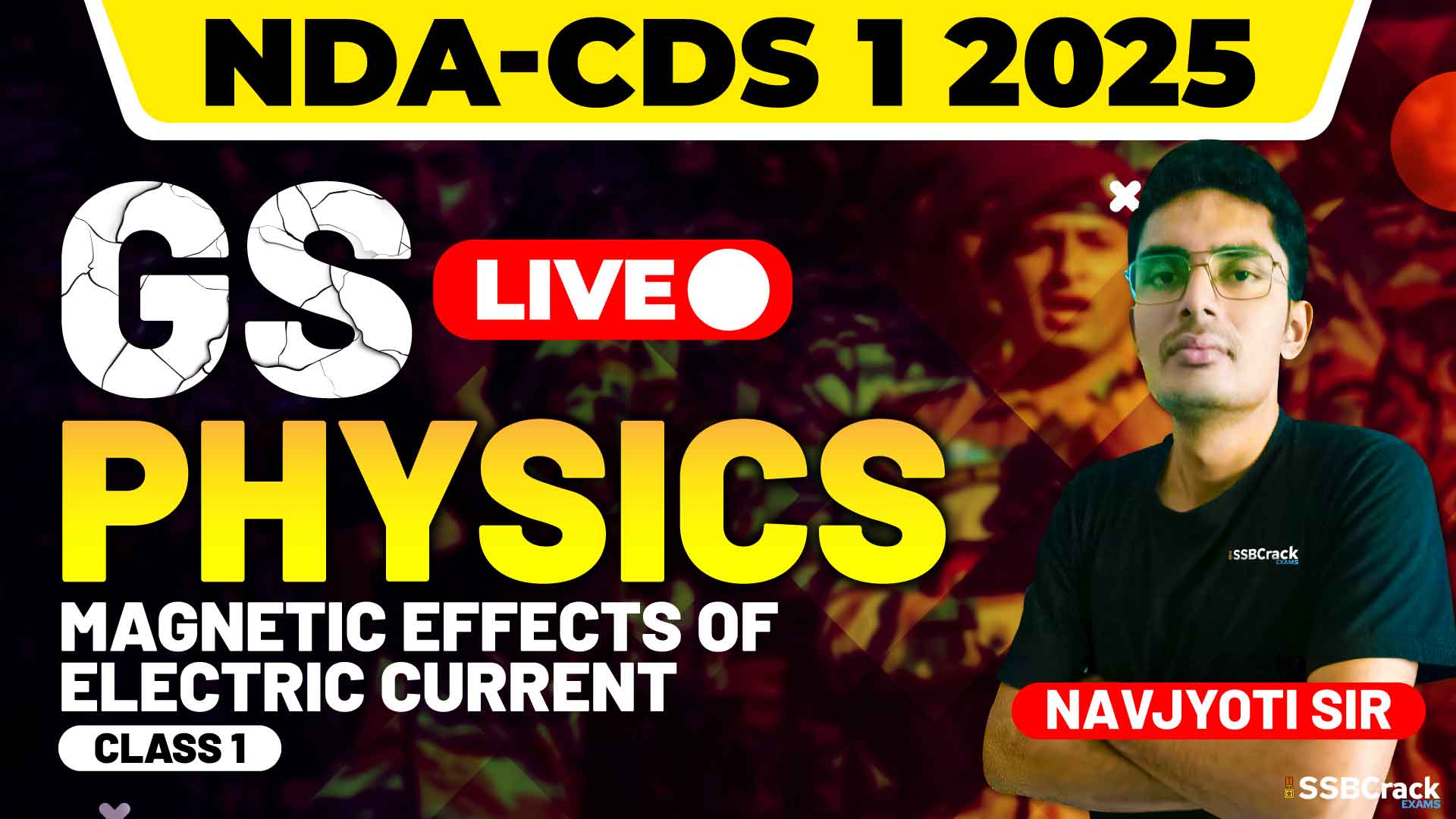Magnetism and electricity are fundamental pillars of physics, intricately connected through the phenomenon of magnetic effects of electric current. This topic plays a critical role in the Physics section of the National Defence Academy and Naval Academy (NDA-NA) Exam and the Combined Defence Services (CDS) Exam. A recent class dedicated to this topic provided students with conceptual clarity and exam-specific preparation strategies.
This blog revisits the highlights of the session, the subtopics covered, and essential strategies for mastering this topic for NDA-NA and CDS exams.
Key Highlights of the Class
The class was an engaging and comprehensive exploration of the topic, designed to build conceptual understanding and enhance problem-solving abilities. Here’s an overview of the subtopics discussed:
1. Magnets and Magnetism
- The class began with a discussion on the properties of magnets, their poles, and the fundamental principles of magnetism.
- Real-world examples, such as the use of magnets in compasses, were used to make the topic relatable.
2. Magnetic Field Lines
- Students were introduced to the concept of magnetic field lines as a visual representation of magnetic fields.
- The instructor highlighted their key characteristics, including how field lines never intersect and the density of lines indicating field strength.
3. Magnetic Field Due to Current-Carrying Conductors
- Straight Wire: The class demonstrated how an electric current through a straight conductor produces a circular magnetic field around it.
- Circular Loop: The magnetic field’s behavior in a circular current loop was explained, emphasizing the field’s uniformity at the center.
- Solenoid: The solenoid’s role as a model of a bar magnet was discussed, with its applications in electromagnets and devices like MRI machines.
4. Forces in Magnetic Fields
- Force on a Moving Charge: Students learned about the effect of magnetic fields on moving charges, leading to applications like cyclotrons.
- Force on a Current-Carrying Conductor: The practical significance of this phenomenon was illustrated through examples such as electric motors.
5. Magnetic Properties of Materials
- The class also explored the classification of materials based on their magnetic properties:
- Diamagnetic: Weakly repelled by magnetic fields (e.g., copper, bismuth).
- Paramagnetic: Weakly attracted to magnetic fields (e.g., aluminum, platinum).
- Ferromagnetic: Strongly attracted to magnetic fields, with the ability to retain magnetism (e.g., iron, nickel).
6. Electromagnetic Induction
- Students delved into the principles of electromagnetic induction, understanding how a changing magnetic field induces an electric current.
- Applications like electric generators and induction stoves were highlighted to demonstrate its practical relevance.
7. Transformers and Generators
- The instructor explained how transformers regulate voltage in electrical circuits and the role of generators in converting mechanical energy into electrical energy.
- Diagrams and real-life examples helped students grasp these concepts effectively.
Preparation Strategies for NDA-NA and CDS Exams
Mastering this topic requires a blend of theoretical understanding, visualization, and problem-solving practice. Here are some strategies to help you prepare:
1. Understand the Basics
- Begin by thoroughly understanding the properties of magnets and the principles of magnetism.
- Familiarize yourself with the concept of magnetic field lines and their representation.
2. Focus on Key Concepts
- Prioritize topics like magnetic fields due to current-carrying conductors, forces in magnetic fields, and electromagnetic induction.
- Pay special attention to the magnetic properties of materials, as they are frequently tested.
3. Use Visual Aids
- Draw diagrams of magnetic field lines around conductors, loops, and solenoids to reinforce your understanding.
- Practice sketching these diagrams to improve speed and accuracy during exams.
4. Relate Theory to Practical Applications
- Connect theoretical concepts to real-world applications, such as electric motors, transformers, and generators.
- Understanding practical uses helps in retaining concepts and answering application-based questions.
5. Solve Previous Years’ Questions
- Practice MCQs from previous NDA-NA and CDS exams to get familiar with the question patterns and difficulty level.
- Focus on application-oriented questions that test your understanding of core concepts.
6. Regular Revision
- Create concise notes summarizing each subtopic and revise them regularly.
- Use flashcards for quick revision of definitions, properties, and key points.
7. Practice Electromagnetic Induction
- Solve questions related to electromagnetic induction, focusing on scenarios involving changing magnetic fields and induced currents.
- Study the working principles of transformers and generators in detail.
8. Mock Tests and Time Management
- Attempt mock tests and practice papers under timed conditions to improve your speed and accuracy.
- Allocate time for each question type and focus on areas where you can maximize your score.
9. Seek Clarification
- Don’t hesitate to ask questions or seek clarification for concepts you find challenging.
- Use textbooks, online resources, or coaching materials to strengthen weak areas.
10. Stay Consistent
- Dedicate specific hours to this topic in your study plan.
- Consistent effort and practice will help you master the topic effectively.
Conclusion
The Magnetic Effects of Electric Current is a vital topic for NDA-NA and CDS exams, requiring a blend of conceptual understanding and practical application. The recent class provided students with the tools to master this topic, focusing on core concepts, problem-solving, and exam-oriented preparation.
To excel, focus on building a strong foundation, practicing extensively, and revising consistently. With a strategic approach and consistent effort, you can confidently tackle this topic and boost your Physics score.
Stay motivated, and success will surely follow!



















